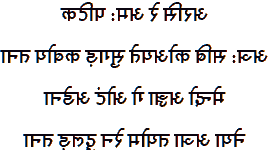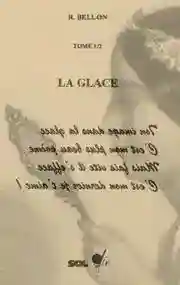Ho love poem
आरसी
अरसि रे अम: पटिक
अञ: सबि कोअयते सुगड़ कबोय तना
मेन्दो अञ्जा गे ओटं अडेना
नेया अञा तयोम रेन दुलड़ तना

With the Warang Citi script
𑢡𑣜𑣞𑣂
𑢡𑣜𑣞𑣂 𑣜𑣈 𑣁𑣖: 𑣘𑣒𑣂𑣌
𑢡𑣍: 𑣞𑣗𑣂 𑣌𑣉𑣅𑣕𑣈 𑣞𑣃𑣋𑣛 𑣌𑣗𑣉𑣅 𑣕𑣓𑣁
𑢶𑣈𑣓𑣔𑣉 𑣁𑣍𑣎𑣁 𑣋𑣈 𑣉𑣒𑣀 𑣁𑣑𑣈𑣓𑣁
𑢳𑣈𑣅𑣁 𑣁𑣍𑣁 𑣕𑣅𑣉𑣖 𑣜𑣈𑣓 𑣔𑣃𑣚𑣉 𑣕𑣓𑣁

→ French poem ←
Ho language
My little love poem is here translated into Ho, the language of 1,500,000 people. (other names and dialects: Bihar Ho, Ho jagar, Ho haram, Lanka Kol, Lohara, Chaibasa-Thakurmunda).
Ho, which is part of the Kherwarian group of the Northern Munda languages, is the language of the Ho aborigines in India (Jharkhand, Odisha, West Bengal), and Bangladesh.
HO, which is the name of the language and the people who speak it, means human.
If the Ho language is primarily oral, when it is written, the scripts used are generally Devanagari, Latin, Odia, and Warang Chiti. Some consider this last one as the script of the Ho language.
In the state of Jharkhand, which has 32 tribal groups, the Ho people are mainly in: Paschimi Singhbhum, Purbi Singhbhum, Ranchi, Dhanbad and Bokaro districts.
The Ho who have occupied the region for much longer than the Indo-Aryans, use their language within the family, as well when they meet others Ho, for example during festivals or ceremonies about Sing bonga.
In general, in addition to Santali, they speak Hindi, English (for the most educated, a low percentage), Oriya or Bengali. Ho is not taught in schools.
The Ho who are one of the large tribes of Jharkhand, are divided into groups of villages, headed by a Manki. Seeking a wife from another caste or tribe is forbidden.
They are generally farmers, but also live from a little hunting, or as workers in the mines.